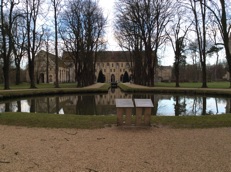 Fondation Royaumont, Val d’Oise, France 16-17 January 2015
Fondation Royaumont, Val d’Oise, France 16-17 January 2015
By Michael Northcott, m.northcott@ed.ac.uk
A Franco-British Research Workshop of grant holders from the AHRC’s Care for the Future grant call and LABEX’s (Laboratory of Excellence) grant call ‘Les passes dans le present: histoire, patrimoine, memoire’ was held at the former Cistercian Abbey of Royaumont 20 miles north of Paris in January 2015. The Abbey was built in the thirteenth century and patronised by Louis XIV. It is situated in a large walled enclosure of gardens, water features and stone buildings. Over the centuries the monks instituted some remarkable hydrological features.The abbey is situated between two lakes on raised ground 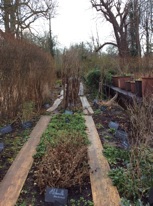 and water from one lake flows through the Abbey grounds and buildings and out to the other lake, Along the way it was stone and sand filtered for drinking water, its flow was used for a mill, while separate channels combined with settlement pools and small weirs were used to separate and cleanse waste water. The resultant water use and supply was very advanced for its era while at the same time the channelling of water around the site considerably enhances the beauty of the buildings and grounds. I was reminded of the similar use of water in the Alhambra at Grenada and indeed the Abbey is an interesting example of Islamic influence on French ecclesiastical aesthetics. This influence is acknowledged in the commentaries provided by the Royaumont Foundation – who are the present owners of the Abbey – on the gardens in which it is pointed out that until 1100 monastic gardens were working gardens providing foodstuffs, herbal medicines and beverage related plants to the monasteries.
and water from one lake flows through the Abbey grounds and buildings and out to the other lake, Along the way it was stone and sand filtered for drinking water, its flow was used for a mill, while separate channels combined with settlement pools and small weirs were used to separate and cleanse waste water. The resultant water use and supply was very advanced for its era while at the same time the channelling of water around the site considerably enhances the beauty of the buildings and grounds. I was reminded of the similar use of water in the Alhambra at Grenada and indeed the Abbey is an interesting example of Islamic influence on French ecclesiastical aesthetics. This influence is acknowledged in the commentaries provided by the Royaumont Foundation – who are the present owners of the Abbey – on the gardens in which it is pointed out that until 1100 monastic gardens were working gardens providing foodstuffs, herbal medicines and beverage related plants to the monasteries. 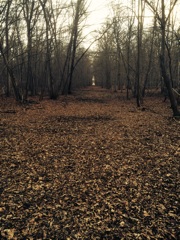 But under Islamic influence the uses of gardens as places of contemplation, and for aesthetic appreciation, became more prominent and vestiges of this turn can be seen income of the restored gardens at Royaumont. The Abbey also had managed woodlands for fuel which can still be seen to the North of the present site.
But under Islamic influence the uses of gardens as places of contemplation, and for aesthetic appreciation, became more prominent and vestiges of this turn can be seen income of the restored gardens at Royaumont. The Abbey also had managed woodlands for fuel which can still be seen to the North of the present site.
The title of the workshop was ‘Delving back into the past to look into the present and future’ and the main aim was to explore interconnections between the AHRC Care for the Future and LABEX Pasts in the Present research calls. Both grant themes sponsor modes of representation of the past from interdisciplinary perspectives. A number of the presentations raised issues relevant to the AHRC Environment and Sustainability theme, and I will just highlight these. A fuller 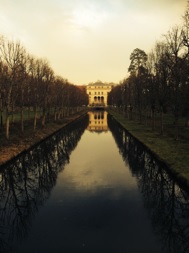 discussion of presentations is available in the blog by Lucy Veale athttp://careforthefuture.exeter.ac.uk/blog Sophie Richter-Devro, from the University of Exeter, in her presentation on her research into the oral history of Bedouin women in Palestine highlighted the difficulties of writing or documenting flexible, ever changing oral traditions, and the dangers of ‘freezing’ narratives and communities. Paulo Jedlowski, from the University of Calabria, in a philosophical presentation on ‘Memories of the Future’ drew on the work of Koselleck in examining portrayals of ‘future presents’ and ‘present futures’, for example in science fiction novels and films, and discussed how such past imagined futures might underwrite intergenerational connections. Intergenerational connections were also addressed by Richard Haynes, from the University of Stirling, whose presentation on sports heritage in Glasgow demonstrated the use of archival research, geo-referencing and mapping activities with school children to engage with communities across generations. The presentation of Carry van Lieshout from the University of Nottingham on the ‘The Power and the Water’ project linked historical with contemporary research around water management, access and the environment, and revealed conflicts and solutions of the past that may be useful today. Lucy Veale of the University of Nottingham gave a presentation on the Extreme weather project in which she highlighted the importance of archive, datasets, memory and narrative in framing present-day responses to extreme weather.
discussion of presentations is available in the blog by Lucy Veale athttp://careforthefuture.exeter.ac.uk/blog Sophie Richter-Devro, from the University of Exeter, in her presentation on her research into the oral history of Bedouin women in Palestine highlighted the difficulties of writing or documenting flexible, ever changing oral traditions, and the dangers of ‘freezing’ narratives and communities. Paulo Jedlowski, from the University of Calabria, in a philosophical presentation on ‘Memories of the Future’ drew on the work of Koselleck in examining portrayals of ‘future presents’ and ‘present futures’, for example in science fiction novels and films, and discussed how such past imagined futures might underwrite intergenerational connections. Intergenerational connections were also addressed by Richard Haynes, from the University of Stirling, whose presentation on sports heritage in Glasgow demonstrated the use of archival research, geo-referencing and mapping activities with school children to engage with communities across generations. The presentation of Carry van Lieshout from the University of Nottingham on the ‘The Power and the Water’ project linked historical with contemporary research around water management, access and the environment, and revealed conflicts and solutions of the past that may be useful today. Lucy Veale of the University of Nottingham gave a presentation on the Extreme weather project in which she highlighted the importance of archive, datasets, memory and narrative in framing present-day responses to extreme weather. 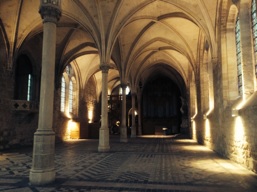 Religious understandings of temporality, and specifically deep time, was tackled by Michael Northcott, of the University of Edinburgh, who described the way geological time – as invented by James Hutton and Charles Lyell -displaced human intergenerational history from earth or natural history, a displacement that the new geological epoch of the Anthropocene reverses in ways that are generative of cultural imaginaries of climate change and species extinction. A presentation by Carlos Lopez Galviz, School of Advanced Study, University of London, compared the nineteenth century development of the urbanscapes of London and Paris, and the role of futuristic imaginaries in their respective shaping. In a helpful summative comment Andrew Thompson observed the importance of recognising the multiplicity of imagined todays, tomorrows and yesterdays in our respective projects.
Religious understandings of temporality, and specifically deep time, was tackled by Michael Northcott, of the University of Edinburgh, who described the way geological time – as invented by James Hutton and Charles Lyell -displaced human intergenerational history from earth or natural history, a displacement that the new geological epoch of the Anthropocene reverses in ways that are generative of cultural imaginaries of climate change and species extinction. A presentation by Carlos Lopez Galviz, School of Advanced Study, University of London, compared the nineteenth century development of the urbanscapes of London and Paris, and the role of futuristic imaginaries in their respective shaping. In a helpful summative comment Andrew Thompson observed the importance of recognising the multiplicity of imagined todays, tomorrows and yesterdays in our respective projects.
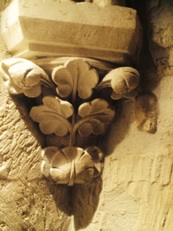 The joint workshop was an excellent example of Franco-British cooperation and a new initiative for AHRC and LABEX. Andrew Thompson and director of the LABEX theme, Marie-Claire Lavabre, in their concluding remarks also indicated their clear and joint intention to launch a joint funding call between AHRC and LABEX for research projects involving collaboration between researchers from the Care for the Future theme and the LABEX ‘Les Passes dans le present’ theme.
The joint workshop was an excellent example of Franco-British cooperation and a new initiative for AHRC and LABEX. Andrew Thompson and director of the LABEX theme, Marie-Claire Lavabre, in their concluding remarks also indicated their clear and joint intention to launch a joint funding call between AHRC and LABEX for research projects involving collaboration between researchers from the Care for the Future theme and the LABEX ‘Les Passes dans le present’ theme.
